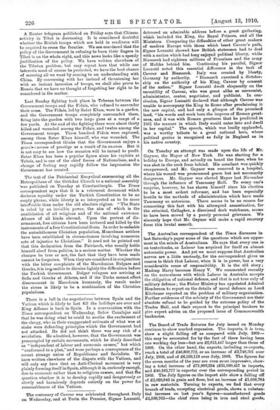The Board of Trade Returns for July issued on Monday
continue to show marked expansion. The imports, it is true, show a slight falling off as compared with July, 1909— this may be accounted for by the fact of there having been one working day less—but are 22,615,447 larger than those of 1908. On the other hand, the exports, including re-exports, reach a total of 246,609,772, or an increase of 23,748,301 over Jaily, 1909, and of 26,593,119 over July, 1908. The figures for the seven months of the year are even more impressive, show- ing a total increase of 271,993,234 (31,830,457 in imports, and 240,162,777 in exports) over the corresponding period in 1909. The July figures on the import side show a falling off of 22,028,942 in grain and flour, but an increase of 21,686,784 in raw materials. Turning to exports, we find that every branch of trade, excepting electrical goods, shows a substan- tial increase on last year's figures—manufactured goods 22,588,762—the chief rises being in iron and steel goods, cotton and woollen fabrics, and apparel. Features of special interest are the increased demand for English clothes, boots, cycles, and motors, the export of British cars having increased seine 60 per cent, as agairfst 1909.







































 Previous page
Previous page